�
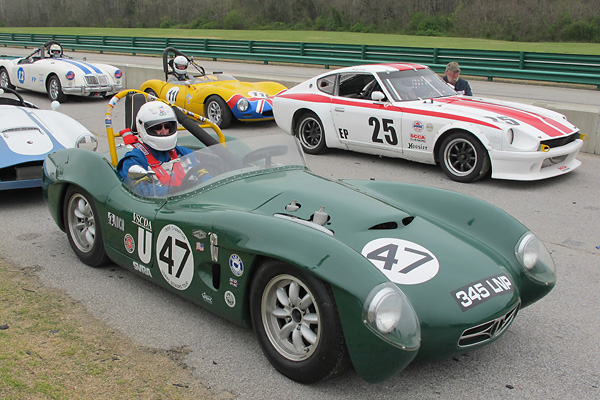
�
Beady Eye Vintage Racing's Tornado ThunderBolt Racecar
� � Owners: Bob Wismer and Bill Dentinger� City: Moline, Illinois
� Model: Tornado ThunderBolt
� Engine: Triumph 2168cc four cylinder�
�
Tornado Cars Limited and The Original ThunderBolt Prototype ("WAU637")
��
Tornado Cars Limited was founded by Bill Woodhouse and Tony Bullen, who worked�
together to develop a stylish fiberglass body and an underslung frame to accommodate�
drivetrain parts from the Ford Popular. They badged this first design Typhoon�
and introduced it to the British marketplace in 1958.�
�
The best thing that can be said of the Ford Popular's 1172cc side-valve flathead engine was�
that it was economical. However, in such a small and lightweight car, its performance was�
satisfactory. Soon Typhoon sales were off to a brisk start. Tornado Cars molded between three�
and four hundred Typhoon bodies. Most were sold as "kit cars," so the number ultimately�
completed is uncertain but the production rate was rapid enough to justify moving to a larger�
building in the small town of Rickmansworth, Hertfordshire (about twenty miles northwest of London).�
In just two years, Tornado Cars grew to about fifty employees and was producing a range�
of model variants, both in kit form and also as completely assembled cars. Subsequent�
offerings would feature the new and much better Ford Anglia 105E engine and ultimately a�
Cosworth-tuned Ford (1340cc) powerhouse, but the partners wanted to produce an offering for�
the two liter class. �
�
Woodhouse and Bullen were convinced their new lightweight fiberglass bodies and purpose built�
sportscar chassis were superior to what Triumph provided in the TR3A model. In 1959, they�
arranged a meeting with Standard Triumph executives and attempted to arrange Triumph's cooperation�
in the sourcing of new Triumph TR3A engines. Perhaps they came across too strong. Triumph was�
already supplying drivetrains to a number of small and independent sportscar manufacturers, but�
for whatever reason Triumph declined Tornado's request.�
�
From the perspective of a kit-car manufacturer, the engine supply problem was an inconvenience�
but certainly not a show stopper. Triumph's early sportscar models had been successful, which�
meant wrecked Triumph donor cars were readily available. A demonstration vehicle was needed�
to promote the Tornado/Triumph combination. �
�
In very early 1960, Bill Woodhouse purchased a wrecked 1956 TR3 and assigned shop foreman�
Eric Martin responsibility for building a prototype. The Triumph's engine, gearbox,�
instruments and various sundries would be used. A Typhoon fiberglass body, in red but with black�
removable hardtop, was selected. It would need a handful of modifications to suit a new and specially�
built chassis and the physically larger TR3 engine. A Laycock overdrive equipped transmission, Ford�
Thames 400E front wishbones, and a Ford Zephyr MkII rear axle were also installed. Ford drum�
brakes would be used at all four corners. Ford Thames van 15" steel disc wheels were used, but�
first a dozen holes were drilled in each, to lighten them.�
�
The Tornado ThunderBolt was first mentioned in race records for the 3/19/1960 race at Goodwood.�
Woodhouse drove, and retired early. The ThunderBolt raced again on 5/21/1960 at Silverstone.�
Woodhouse drove again, and finished third. Silverstone track records and various media reports�
from the period indicate the ThunderBolt was capable of 135-145mph top speeds, and the�
company claimed to have clocked the ThunderBolt at 153mph in testing, but the car's handling�
got mixed reviews. In August 1960, Autosport magazine summed it up this way: "blindingly fast,�
but a real handful to drive." Their judgement may have been pre-mature though. At approximately�
this time a veteran Triumph racer named Colin Hextall joined Tornado, bringing a wealth of racing�
skill and experience with him. In September, the ThunderBolt anchored Tornado's three-car works�
team to a first overall finish in the six-hour 750 Motor Club relay race at Silverstone. That was the�
Tornado company's proudest moment.�
�
�
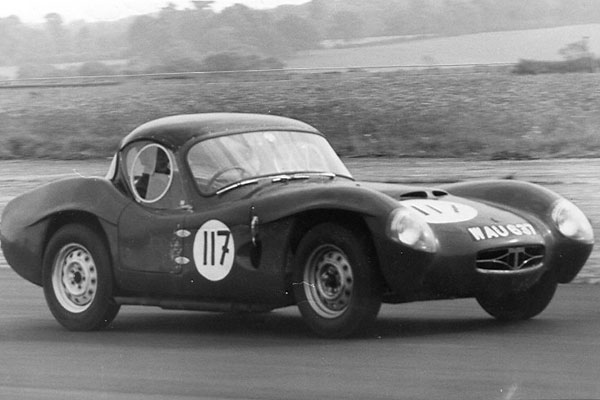
�
Colin Hextall pilots WAU 637 at Silverstone, 18 June 1960. (photographer: unknown)
�
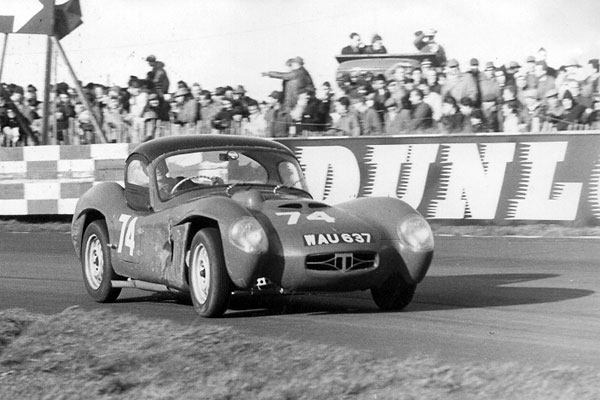
�
Colin Hextall drives WAU 637 at Brands Hatch's Boxing Day Meet, 1960. (photographer: unknown)
�
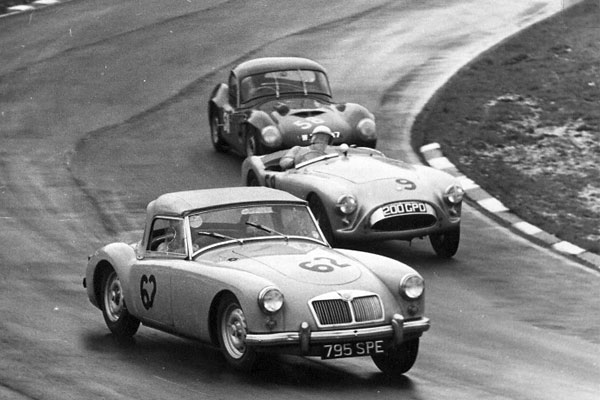
�
W. Evangelista (#62, MGA) is lapped as Bill Shaw (#59, AC) and Colin Hextall (#58) battle for third.
�
Brands Hatch, 3 April 1961. (photographer: unknown)
�
�
The Tornado team continued refining and racing the ThunderBolt through at least July 1962,�
with driving shared by four teammates: Bill Woodhouse, Colin Hextall, Eric Martin, and Mike�
Hutchings. Richard Page has kindly shared with us his study of the ThunderBolt's race results.�
Please see below for the full report. The period photos shown here are from Bob Wismer's�
collection.�
�
By late 1961, Tornado was ready to begin phasing out their original body styling and�
transitioning to a more modern appearance in the form of a new model called Talisman.�
About 200 Talisman bodies would be produced, before cash flow problems loomed large.�
By 1964, all production of Tornado cars ceased. Eric Martin was offered the ThunderBolt�
racecar as the company collapsed. He took the chassis, but left behind the body, then�
cut and extended the original frame by about ten inches to suit a Talisman GT body.�
Soon thereafter, Eric Martin sold the car. In Talisman GT form, WAU637 was occasionally�
raced in the late sixties and early seventies, and then was stored. Re-acquired by the�
Martin family in 2003, WAU637 has now been restored to its original length and body style.�
The family has said they have no plans to race the veteran car.�
�
�
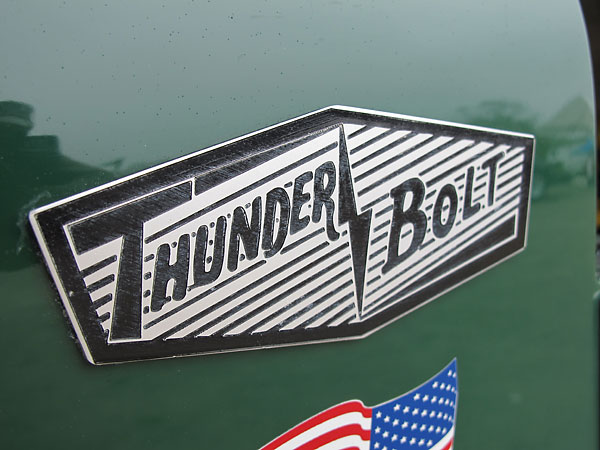
�
ThunderBolt emblem.
�
Tornado ThunderBolt #2 ("345LNP") and Beady Eye Vintage Racing
��
Unfortunately, Bill Woodhouse's telephone didn't exactly ring off its hook with orders for�
ThunderBolts, but sometime in late 1961 the phone did ring and someone inquired about�
buying a Typhoon body to put on their own Triumph-powered chassis. This second�
ThunderBolt, restored and refined, is featured throughout the balance of this article.�
�
ThunderBolt number two was originally built by Colin Ford of Droitwich in Worcestershire.�
Colin Ford was a motorcycle mechanic who had seen a couple Typhoon brochures and come independently�
to the idea of marrying a Typhoon body with a more powerful engine and a heavier duty chassis. He�
ordered a body and a removable hard-top, both in basic black. Working with a very limited budget�
and modest performance goals, Colin Ford decided a 1949 Standard van would serve him fine as a�
donor car instead of the Triumph TR3 that Tornado suggested. Ford started turning wrenches�
on his project in late 1961 or early 1962. His ThunderBolt was completed and first registered (345LNP)�
in July 1963.�
�
Colin Ford's Standard van came with a 2088cc engine, which was a less tuned version of �
the same engine put in Triumph badged sportscars. At some later but undocumented date, Colin Ford�
procured and installed a TR3 cylinder head. He used the van's three speed gearbox and overdrive,�
not a four speed. Rather than build a frame from scratch, he modified the van chassis with extra�
outboard rails to support the Tornado fiberglass bodywork. The car was built for daily use,�
and was never raced by its original builder but it's believed that a subsequent owner occasionally�
used it for trials in the late sixties and early seventies. �
�
In the mid-to-late seventies, Henry Kovar of St.Cloud Minnesota purchased the ThunderBolt from�
an English dealer. Kovar is known to have raced the ThunderBolt at least once at Brainerd International�
Raceway in Minnesota. At some point the front right fender got smashed, and the car then fell�
into a period of sad neglect. �
�
�
IMPORTANT ANNOUNCEMENT
�
BritishRaceCar.com will have to cut back plans for continued growth if we can't find more financial support.
�
If you like what you've found here, and you want to see more, please click here and follow the instructions.
�
Readers like you keep BritishRaceCar.com online and growing through voluntary financial contributions.
�
�
Longtime Triumph enthusiasts and vintage racing partners Bob Wismer and Bill Dentinger purchased�
345LNP in 1993 and committed to giving it an extensive restoration, but with a major difference:�
they would discard the van chassis and instead replicate the purpose-built racing chassis�
of ThunderBolt number one!�
�
Bob traveled to England to research the original design, and in the process of doing so he�
met with many of the original players. David Malins of the Tornado Register provided invaluable�
assistance. He also received extensive and personal input from Bill Woodhouse,�
Eric Martin, and the family who owned the Talisman ThunderBolt (WAU637) at that time.�
With copies of the original drawings and build notes in hand, Wismer and Dentinger were able�
to work efficiently, and their restoration project was completed in 1996.�
�
There are just a few cosmetic differences between the original ThunderBolt racecar and the current�
one. Firstly, British racing green paint versus red. Secondly, since both Bob and Bill are over six�
feet tall and the original drivers were about five foot seven, the factory-original windscreen and hardtop�
have been left uninstalled. The hardtop that came with their car (complete with its peculiar round/rotating/venting�
side windows) is kept carefully stored-away and could be reinstalled at some time, although the�
process isn't exactly convenient because it attaches to the body with forty bolts and because it�
can't be installed until after the current elaborate wrap-around windscreen is first removed and�
replaced. There are other differences, but for that matter the original ThunderBolt changed quite�
noticeably over its racing career. (My own analysis of old photographs suggests that it may have�
had three different bonnets and two different hardtops.)�
�
Under the skin there are many mechanical differences between WAU637 and 345LNP, as we'll�
show in photos below. Mostly, the differences were required for practical reasons because the�
goal of the restoration was to end up with a raceable car. Safety, reliability, and availability of�
service parts in North America were all important requirements.�
�
Very few cars are so enthusiastically raced! 345LNP has now completed over one hundred vintage�
racing weekends since its restoration. Wismer and Dentiger have raced their ThunderBolt at almost�
every major road-racing circuit in North America. �
�
Please support the sponsoring companies who make www.BritishRaceCar.com possible, including:
� �
 �
�
�
�
Features and Specifications
�| Engine: | �Triumph TR4 four cylinder engine.�
Original Triumph TR4 crankshaft (balanced, stress-relieved, and nitrided.) �
87mm flat-top racing pistons.�
(Static compression ratio is between 10.5 and 11:1.)�
Iskendarian 666-grind camshaft.�
Heavy duty valve springs.�
Stiffened rocker shaft.�
Flowed cylinder head.�
Dual S.U. H6 carburetors with special aluminum floats to avoid sinking.�
K&N filter currently fitted in lieu of (disconnected but still installed) filterless cold air induction system.�
Lucas distributor with Pertronix breakerless module.�
(A Crane XR700 ignition module is installed, but currently disconnected).�
Bosch "blue" ignition coil.�
Belden Premium 7mm Metallic spark plug cables. | �
| Cooling: | �custom aluminum crossflow radiator.�
Serck brass pressurized coolant header tank.�
Electric cooling fan.�
Aluminum oil cooler. | �
| Exhaust: | �custom exhaust system including four-into-one header, built by Kevin Potter. | �
| Transmission: | �Triumph Competition (TR4) four speed, with close ratio gears.�
Aluminum flywheel.�
Tilton Engineering racing clutch. | �
| Front Susp.: | �Triumph upper and lower control arms; the lower ones have been cut and lengthened.�
Coilover shock absorbers.�
Anti-sway bar.�
Triumph TR4 steering rack. | �
| Rear Susp.: | �multi-link rear suspension. (See below.)�
Coilover shock absorbers.�
No rear anti-sway bar. | �
| Rear Axle: | �TR4 axle housing, modified by Southwick Machine and Design to use billet axles.�
3.7:1 final drive ratio.�
Quaife limited slip differential. | �
| Brakes: | �(master) Wilwood dual master cylinders with Tilton remotely adjustable bias bar. � (front) Girling calipers, � (rear) Girling calipers. | �
| Wheels/Tires: | �Panasport aluminum 8-spoke (6-JJx15) wheels with�
Dunlop Racing CR65 Mark II tires (5.50L-15 front and 5.00L-15 rear.) | �
| Electrical: | �Power Patrol SLA1165 (sealed lead acid) battery.�
TS Imports gear reduction starter, painted black. | �
| Instruments: | �(left to right)�
Stewart Warner fuel pressure gauge (1-10psi),�
VDO coolant temperature gauge (110-270F),�
Smiths speedometer (0-120mph, 46245 miles on the odometer),�
Jaeger cable driven tachometer (0-6000rpm),�
Autometer oil temperature gauge (140-280F),�
Smiths oil pressure gauge (0-100psi). | �
| Fuel System: | �Fuel Safe eight gallon fuel cell.�
Dual Facet solid state electric fuel pumps, in series. � Adjustable fuel pressure regulator. | �
| Safety Eqpmt: | �G-Force five point cam-lock safety harness.�
Momo suede covered steering wheel on a Sweet Mfg. quick release hub.�
Amerex Halon fire extinguisher. | �
| Weight: | �1650 pounds. | �
| Performance Notes: | �engine redline is 6000rpm which corresponds to 123mph in fourth gear.�
The engine's power band is from 5000 to 6000rpm. | �
| Shared credit: | �Body and chassis work by John Reimer, Caledonia Automotive Service. � Original engine and transmission built by the late Mike Belfer. � All mechanical work since 1995 has been done by Kevin Potter, the Beady Eye Vintage Mechanic. | �
| Racing Class: | �VDCA Group 3, D-Production | �
Please support the sponsoring companies who make www.BritishRaceCar.com possible, including:
� �
 �
�
�
�
Engine Installation
��
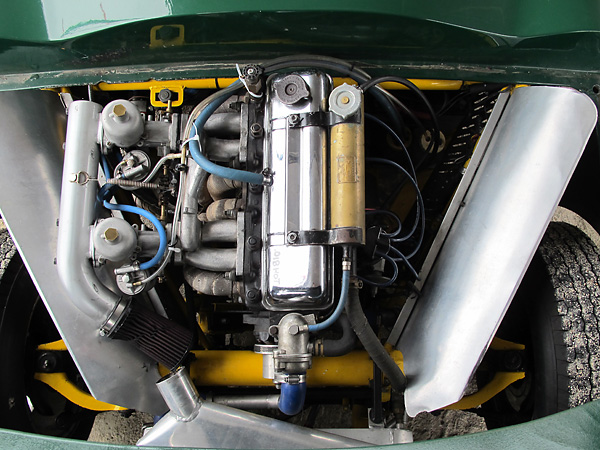
�
Triumph TR4 four cylinder engine.
�
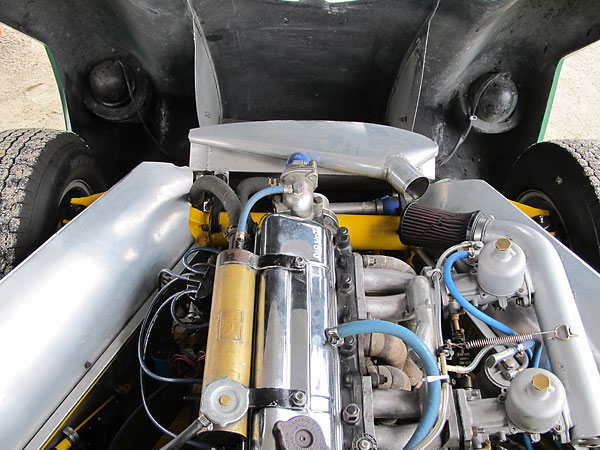
�
All mechanical work since 1995 has been done by Kevin Potter, the Beady Eye Vintage Mechanic.
�
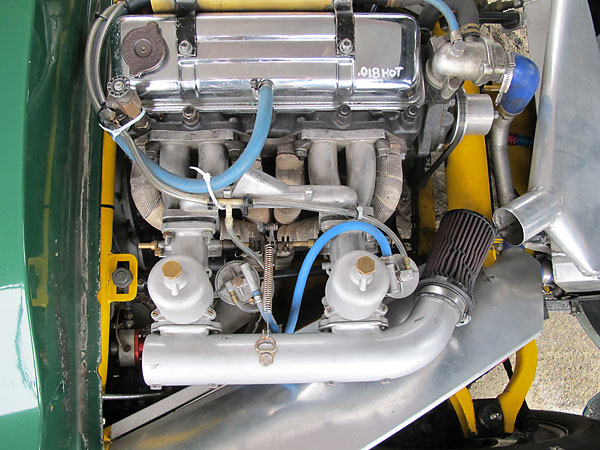
�
Dual S.U. H6 carburetors with special aluminum floats to avoid sinking. A K&N air filter currently fitted,
�
in lieu of a fabricated aluminum (disconnected but still installed) filterless cold air induction system.
�
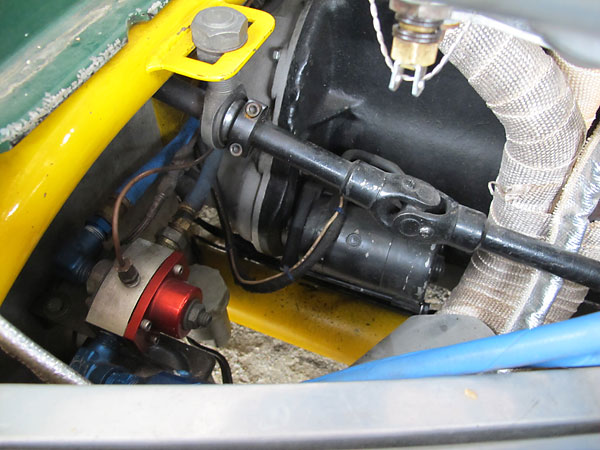
�
foreground: High-misalignment Heim joint and Sweet Manufacturing steering universal joint.
�
at left: Wilwood brake master cylinder, adjustable fuel pressure regulator, and Girling clutch slave cylinder.
�
background: lightweight TS Imports gear reduction starter, painted black to be less conspicuous.
�
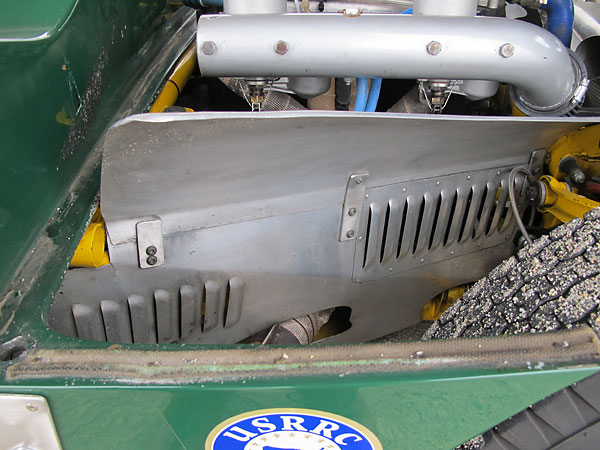
�
You can see here that the exhaust header has been wrapped with a special high temperature textile tape.
�
This has the dual benefit of keeping exhaust gases hotter (which improves how they flow) and keeping
�
the induction system cooler. Header wrap can also spare mechanics from nasty accidental burns.
�
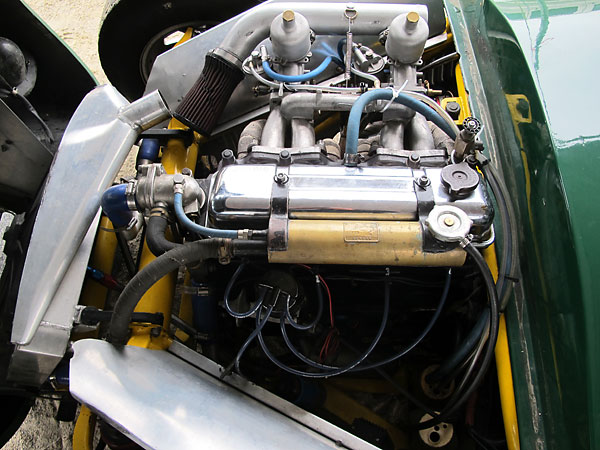
�
A coolant header tank ensures that the highest point in the system can be conveniently vented.
�
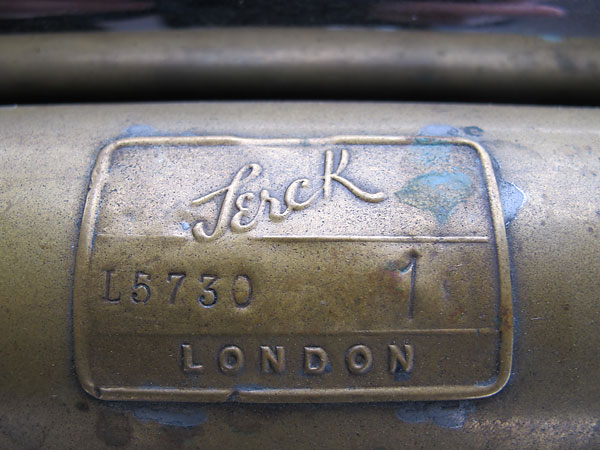
�
The brass pressurized header tank is labeled "Serck L5730 1 London."
�
(Serck was acquired by the Unipart Group and continues to manufacture radiators today.)
�
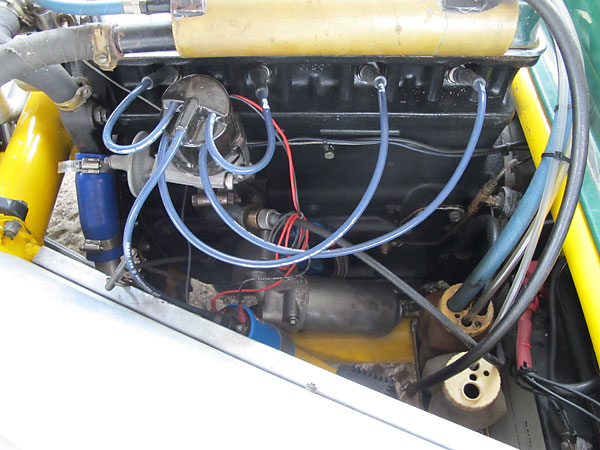
�
Lucas distributor, Bosch blue ignition coil, and Belden spark plug wires.
�
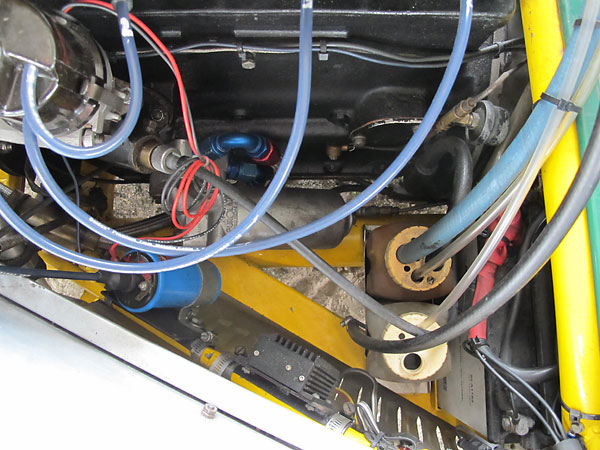
�
A Crane XR700 electronic ignition module is installed, but apparently temporarily disconnected.
�
At bottom right, a small sealed lead acid battery is tucked neatly against the firewall.
�
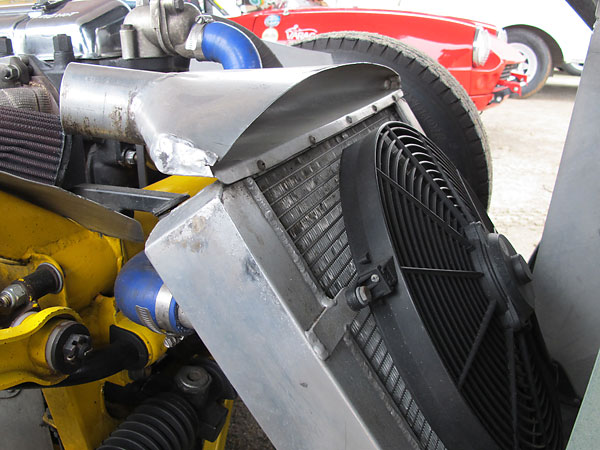
�
Cold air induction. Custom aluminum crossflow radiator. Electric cooling fan.
�
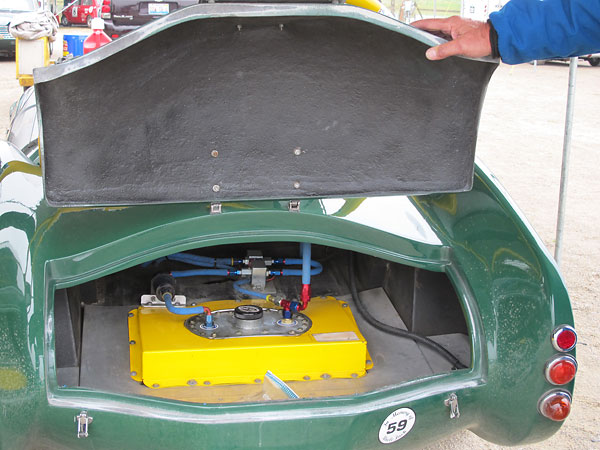
�
Fuel Safe eight gallon fuel cell.
�
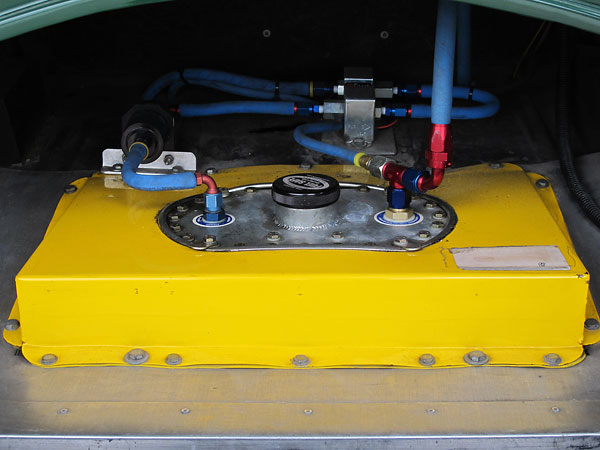
�
Dual Facet solid state electric fuel pumps, in series.
�
Front Suspension
��
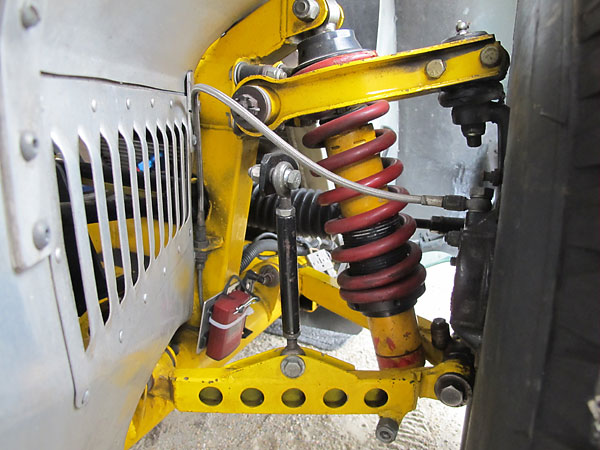
�
Triumph upper and lower control arms; the lower ones have been sectioned and lengthened.
�
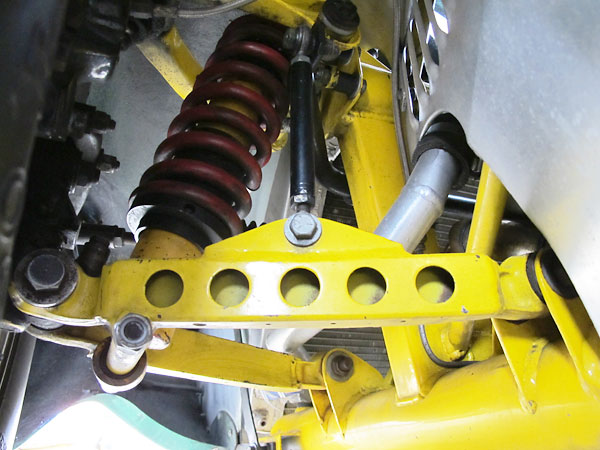
�
Castor and camber can be adjusted by shimming the upper control arm mounting points.
�
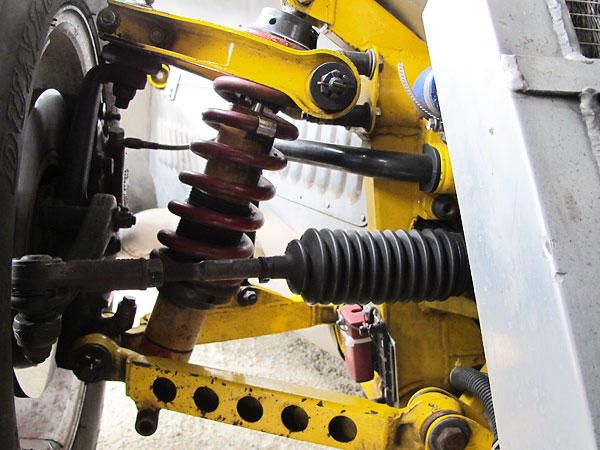
�
Coilover shock absorbers were available in 1960, but not with threaded collars for easy
�
adjustment of ride height and corner weights.
�
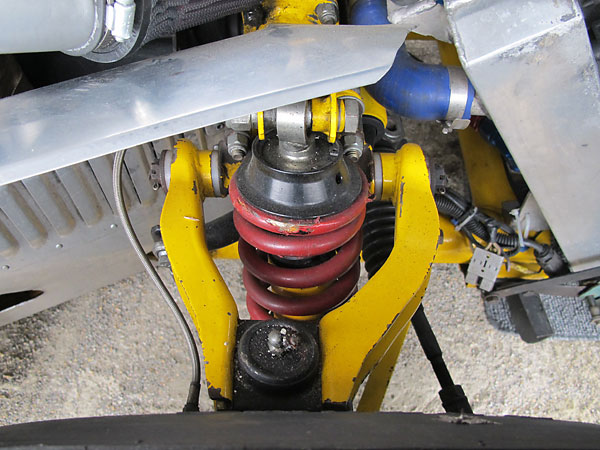
�
Nylon replacement suspension bushes are less compliant than rubber.
�
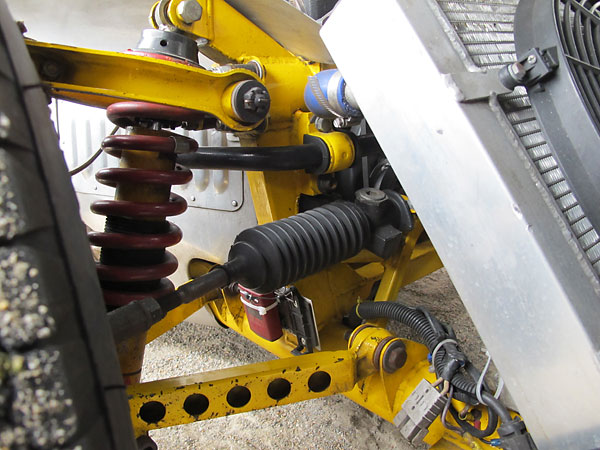
�
The original ThunderBolt (WAU637) used Ford Thames 400E front wishbones.
�
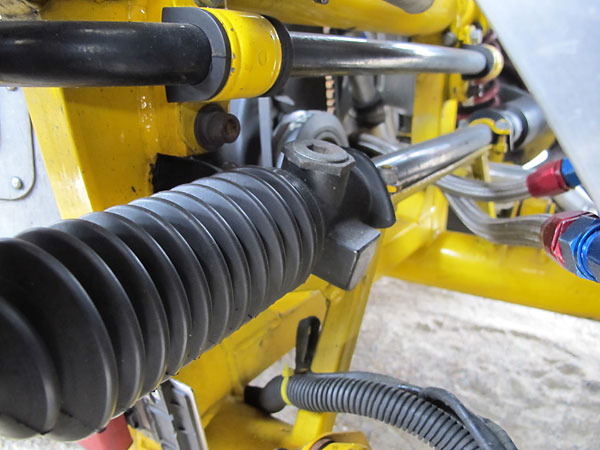
�
This Triumph TR4 steering rack can be shimmed up/down to eliminate bump steer.
�
�
Frame and Rear Suspension
��
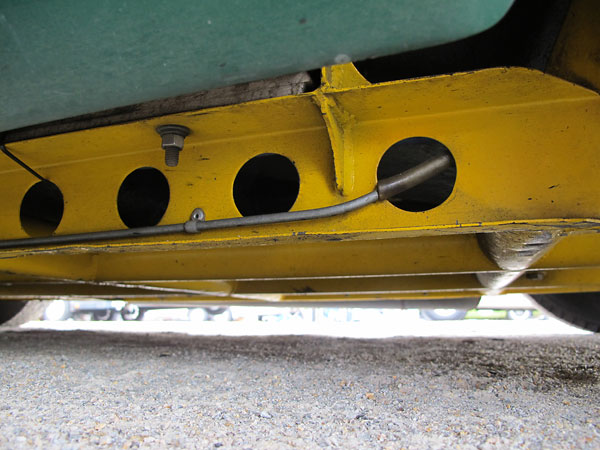
�
"The chassis frame is immensely strong and is constructed around a backbone of 3.5 inch tubes spaced
�
one foot apart run the length of the car. These members are cross braced by six further 3.5 inch tubes
�
giving great torsion stiffness. Four 3.5 inch tubular outriggers on each side join to 3.5 inch by 14 gage
�
channel side members on which are the main body attachment points. Smaller diameter tube
�
spaceframe sub-assemblies front and rear carry the upper front wishbones and front suspension units,
�
together with engine mountings and rear suspension units and boot floor respectively. The independent
�
front suspension is of the wishbone type with unequal length inclined arms giving a controlled degree
�
of negative camber on bump movement." (excerpted from original Tornado Cars Ltd. sales literature)
�
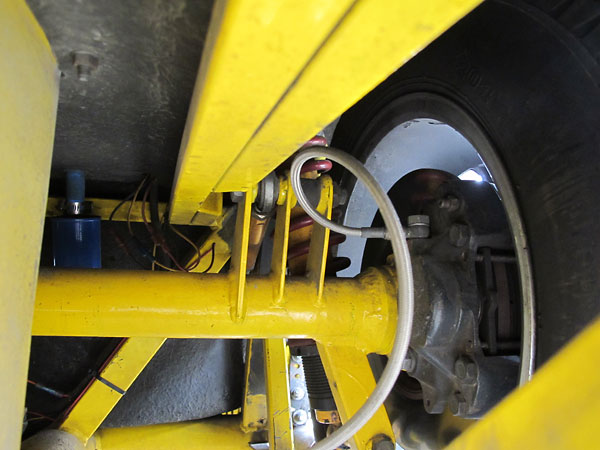
�
Although WAU637 used a Ford Zephyr MkII rear axle, 345LNP has always had Standard Triumph axles.
�
Bob and Bill use the Southwick Machine and Design Company of Colona Illinois modified Triumph TR4
�
beam axle housing. It utilizes welded-on Ford axle ends and one-piece billet steel shafts with integral hubs.
�
This is stronger and safer than a stock Triumph axle, and the weight difference is trivial.
�
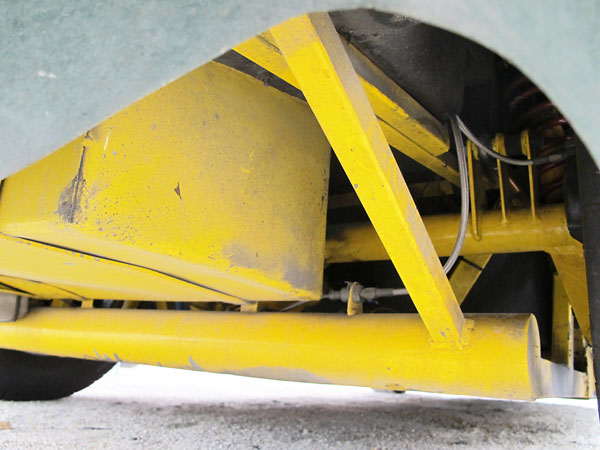
�
Inside the axle, the Beady Eye team usually uses a 3.7:1 gear set and a Quaife limited slip differential.
�
3.5, 4.1, 4.3, 4.55 and 4.87 ring and crown gear sets are readily available for Triumph TR3 and TR4 axles.
�
Quaife differentials are popular on high performance street cars because their operation is very smooth.
�
With a Quaife, by design, there's no condition where the two sides of the axle are ever locked together.
�
Many racers prefer the sheer grunt on demand of a locking or welded differential.
�
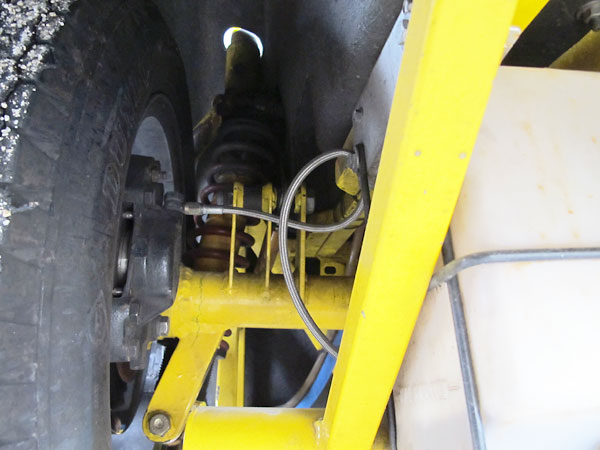
�
The Thunderbolt features a variant version of a "three link" rear suspension. Above the outboard ends
�
of the axle are radius rods extending forward to the frame. In the center, below the axle, is a V-shaped
�
rod that serves to restrain pinion angle change and restrict lateral movement of the axle (thereby making
�
a Panhard rod or Watt's link unnecessary). The rear suspension's roll center is located where the axle
�
pivots on its connection to the V-rod, and thus is relatively low.
�
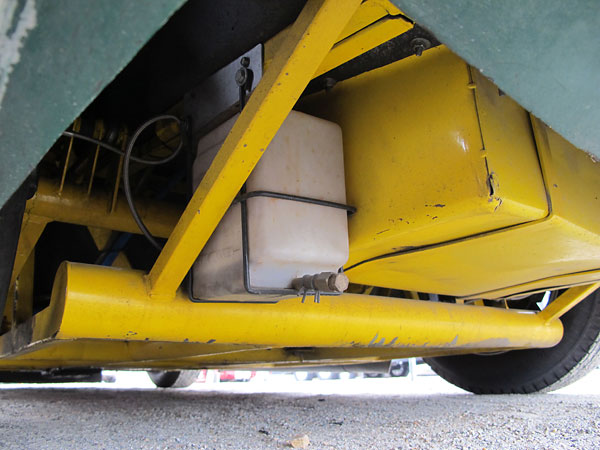
�
The overflow tank for the engine's cooling system, mounted next to a Fuel Safe eight gallon fuel cell.
�
�
Interior
��
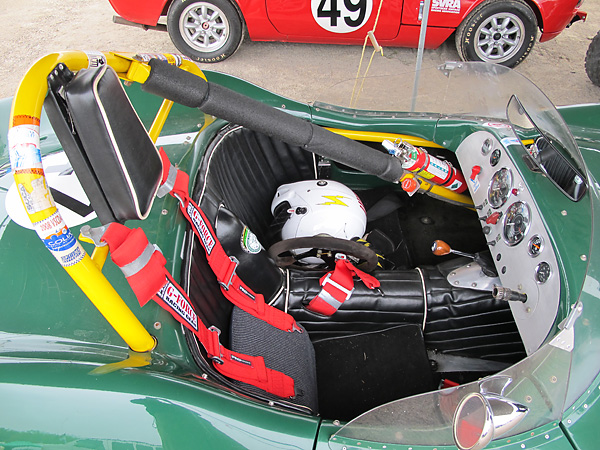
�
Tornado molded the Typhoon/Tempest/ThunderBolt body in multiple styles including a 2+2 version,
�
but the two-seater was the most popular version. Note that backrests were molded right into the body.
�
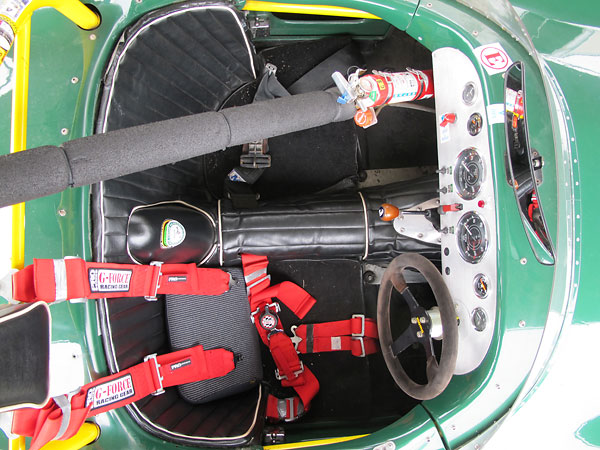
�
G-Force five point cam-lock safety harness.
�
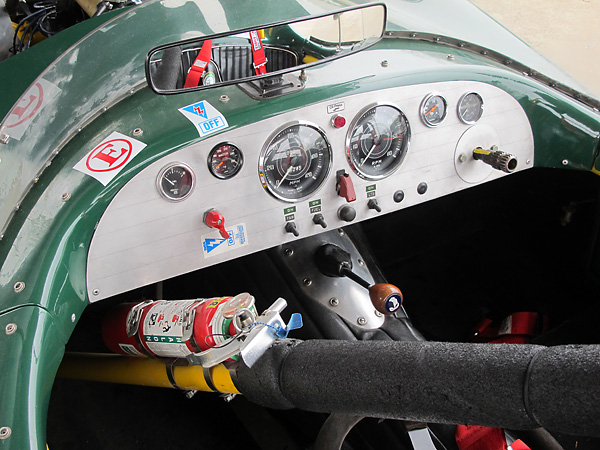
�
(left to right) Stewart Warner fuel pressure gauge, VDO coolant temp gauge, Smiths speedometer,
�
Jaeger cable driven rev counter, Autometer oil temp gauge, and Smiths oil pressure gauge.
�
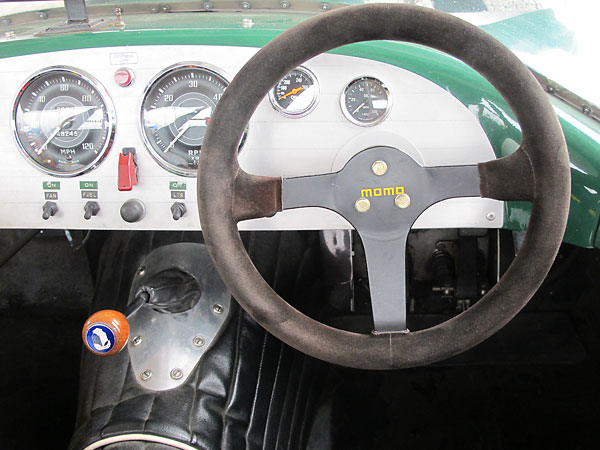
�
The shifter lever pivot point is rather far forward.
�
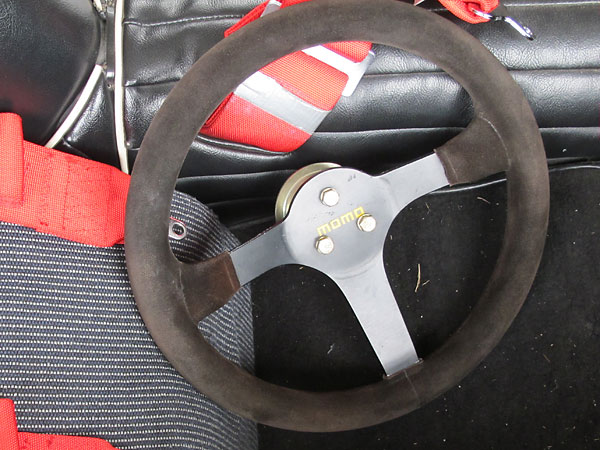
�
Momo suede covered steering wheel.
�
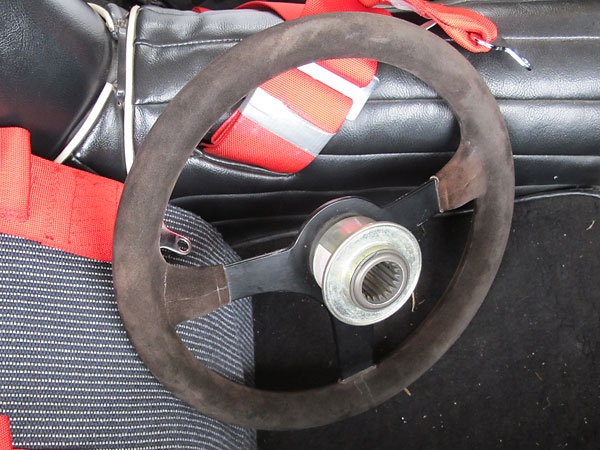
�
Sweet Manufacturing quick-release steering hub.
�
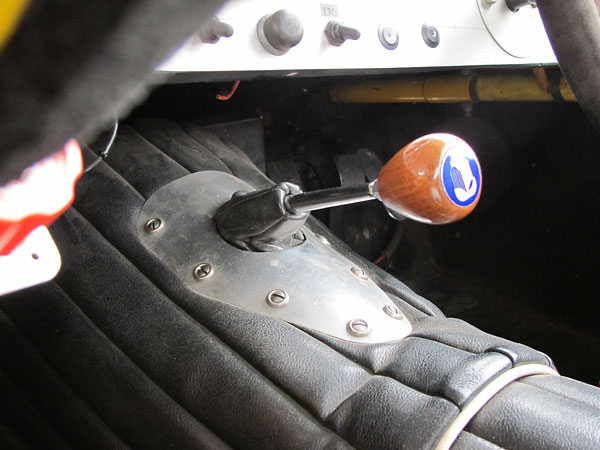
�
Triumph logo shifter knob connects the driver to a TR4 four speed, upgraded for racing with a Triumph
�
close-ratio gear set. The first ThunderBolt, WAU637, was built with a TR3 four speed. The TR4 version is
�
mostly similar except it has synchronizers on first gear. Also, during the production run Triumph beefed
�
up the TR4 transmission's aluminum case with webbing.
�
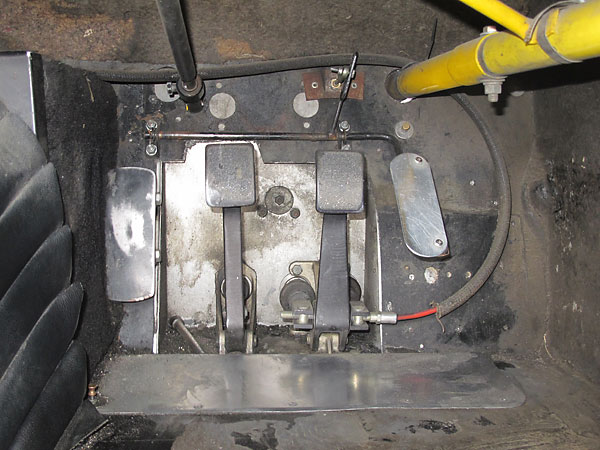
�
The brake system is much improved over original. Here we see how a Tilton remote-adjuster cable routes to
�
the "bias bar" that connects dual master cylinders. The bias bar is threaded, and by rotating it the driver
�
is able to shift a fulcrum point from side to side. In doing so, he can fine tune front-to-rear brake bias.
�
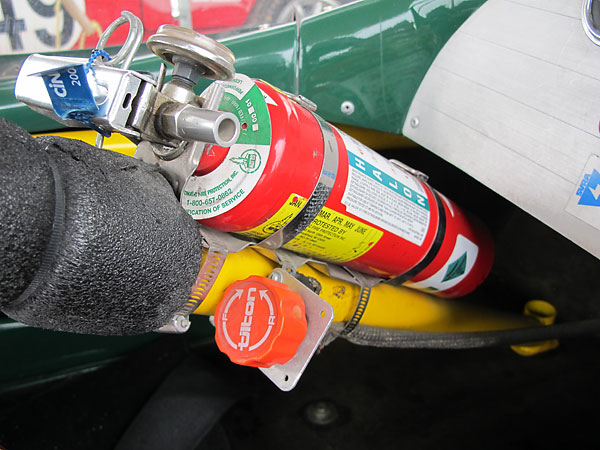
�
The Tilton brake bias adjustment knob, and an Amerex Halon fire extinguisher.
�
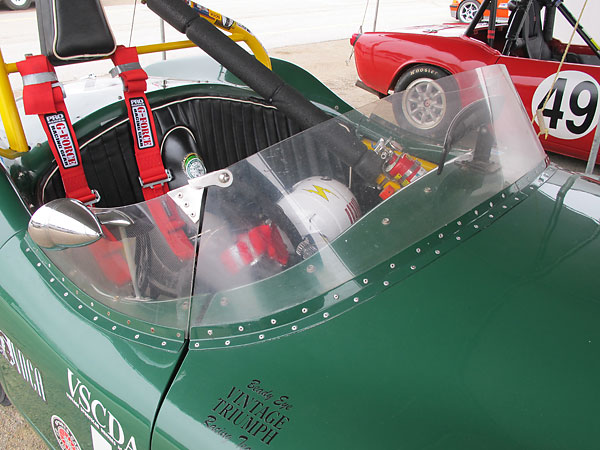
�
Perspex wrap-around windscreen. (Like Plexiglas, Perspex is a trade name for acrylic.)
�
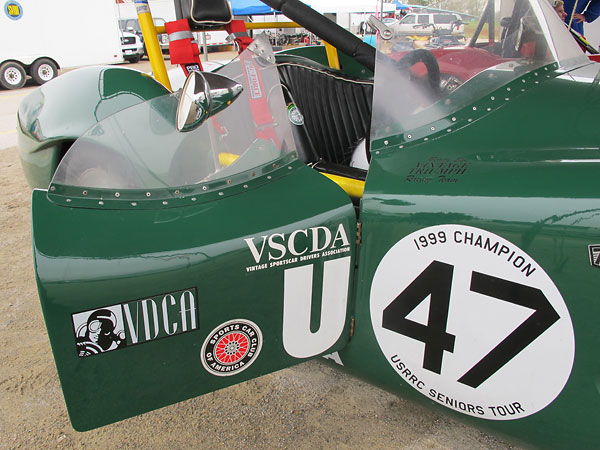
�
Hidden hinges. (On WAU637 and most other Tornados, door hinges were mounted on the car's exterior.)
�
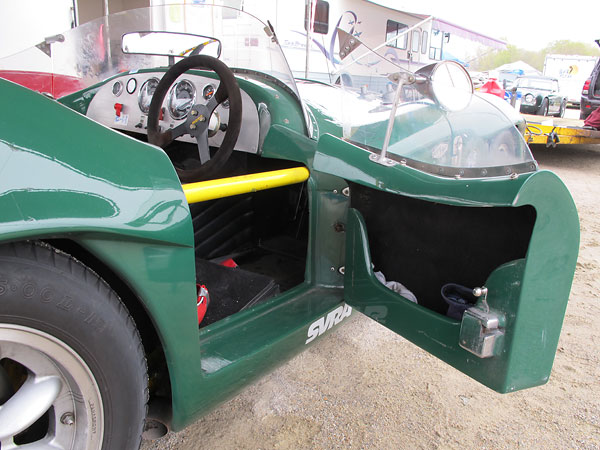
�
Convenient storage pockets in the doors.
�
�
Exterior
��
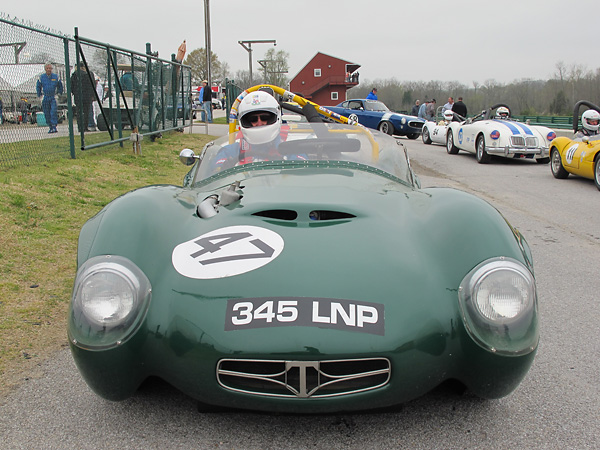
�
Bob Wismer has queued up to race his Tornado ThunderBolt at Virginia International Raceway,
�
near Danville, on the North Carolina State line. The "Wild Hare Run" is an annual race event,
�
organized by the Vintage Drivers Club of America (VDCA) and the Vintage Racer Group (VRG).
�
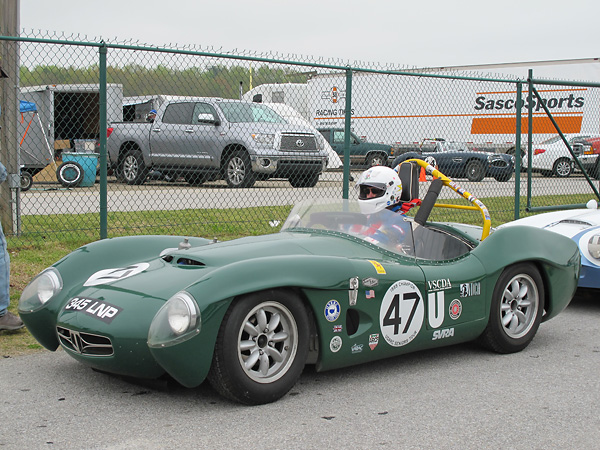
�
I enjoyed seeing the ThunderBolt queued up to race with a pristine Turner sportscar.
�
Rivals or birds of a feather? From the same era and built with similar construction
�
techniques and materials... today their owners share the Fairthorpe Sports Car Club.
�
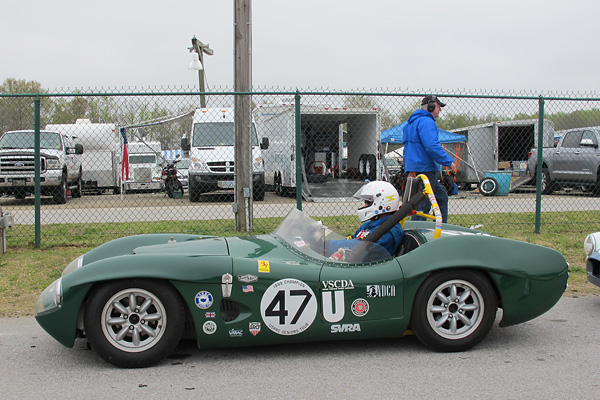
�
Simply dashing!
�
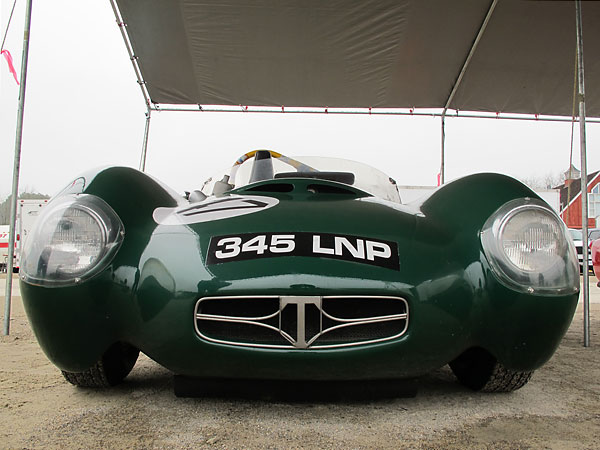
�
Tornado's logo on this grille-work is the closest the Tornado company came to putting their name on the car,
�
but they did create distinctive "ThunderBolt" logo emblems, as shown above.
�
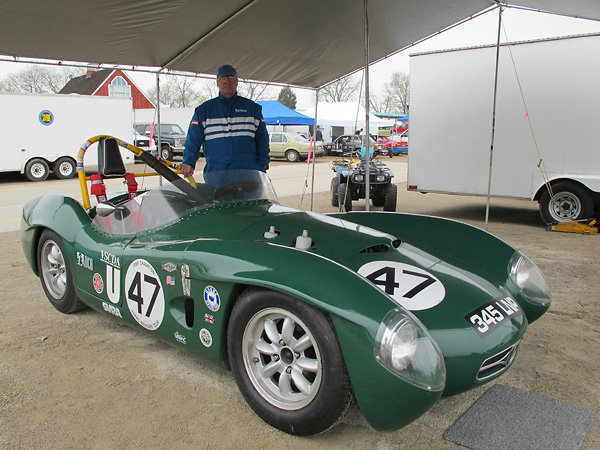
�
Bob Wismer is deservedly proud of this extremely well-presented and rare vintage racecar.
�
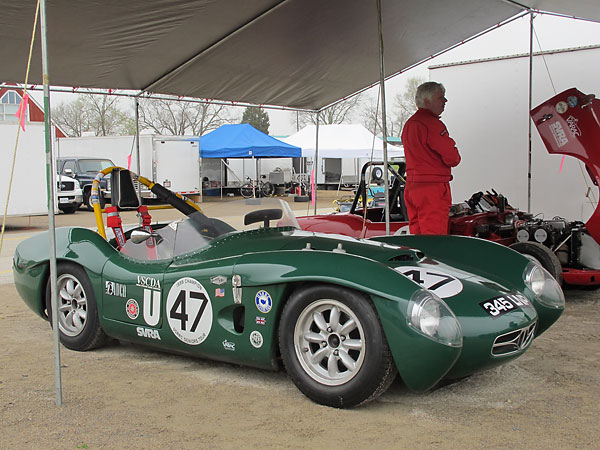
�
Frankly, the Tornado ThunderBolt is a very much more attractive car with its hardtop removed.
�
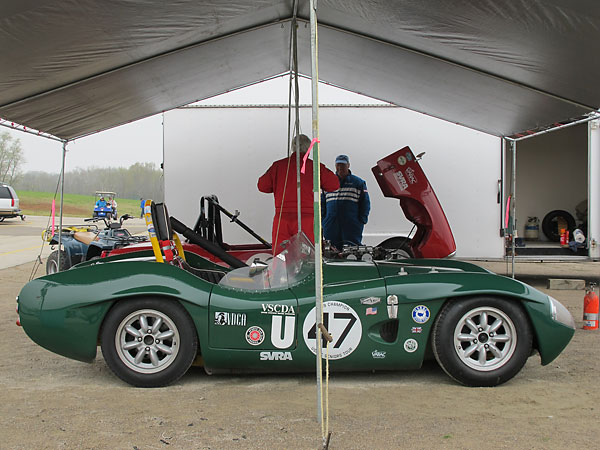
�
Tornado offered quite a variety of roof and windscreen treatments on its Typhoon, Tempest, and Thunderbolt
�
models. They offered 2+2 seating, and even "SportsBrake" models. A SportsBrake is sort of a cross between
�
a GT (in the sense of a Triumph GT6 or an MGB-GT) and a station wagon. Funny thing, they're rare now...
�
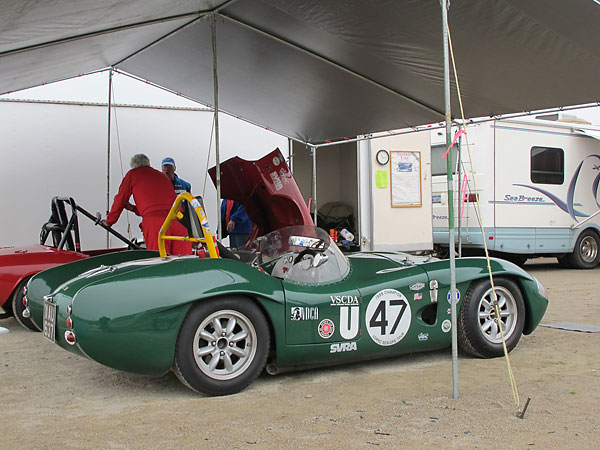
�
In principle a Tornado Tempest is essentially a Typhoon except with the more powerful Ford 105e
�
type engine. However, in detail Tempests came with much improved chassis and suspensions.
�
Only about a dozen Tornado Tempests were built.
�
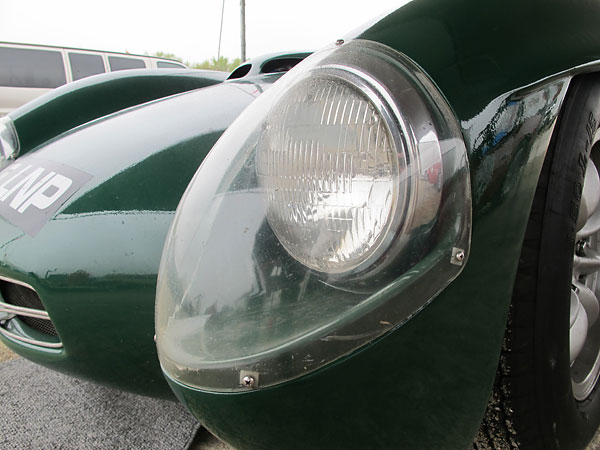
�
Transparent Perspex headlight fairings were a very progressive idea for a 1959 model car!
�
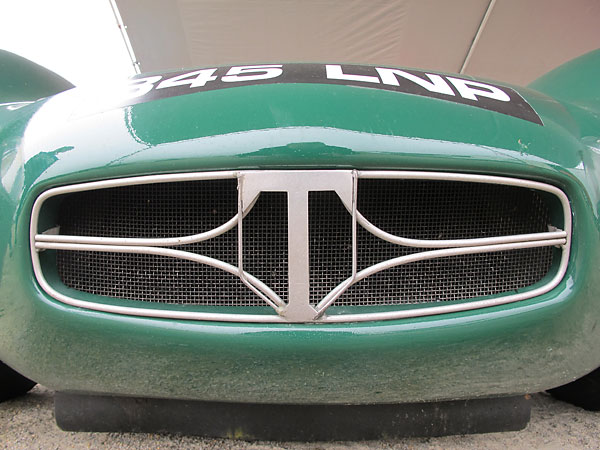
�
The ThunderBolt's body is low and streamlined but it has an aerodynamic problem: on really fast tracks like
�
V.I.R. or Road America the body can develop enough aerodynamic lift to be scary. This stiff rubber skirt is a
�
very simple and effective quick-fix, until an even more discrete solution can be implemented.
�
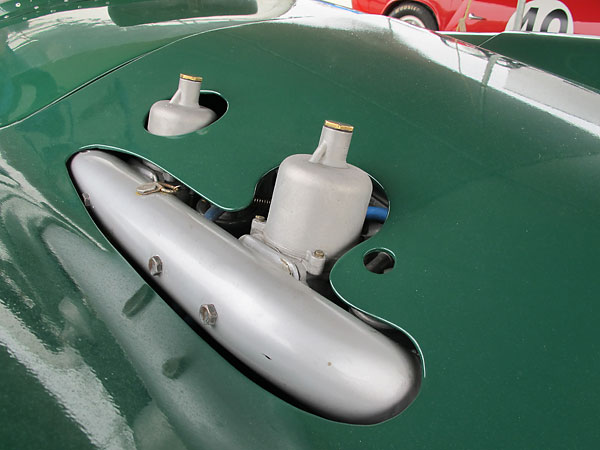
�
Contoured carburetor clearance hole in the bonnet. Old photographs show a variety of treatments
�
were used in this area: sometimes a contoured hole and sometimes a tall performance blister.
�
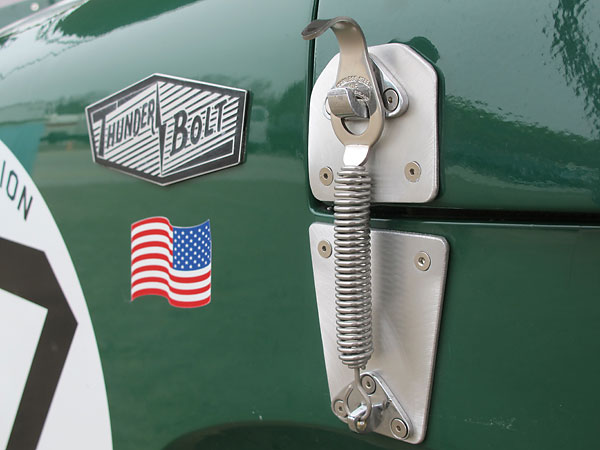
�
Terry stainless steel bonnet hold-down.
�
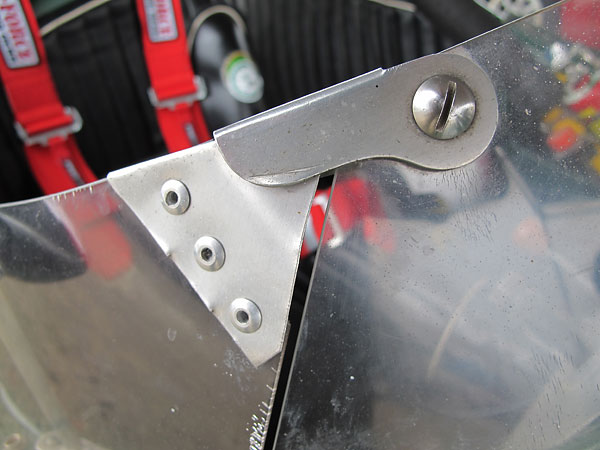
�
This clip aligns the front windscreen and the drivers side window.
�
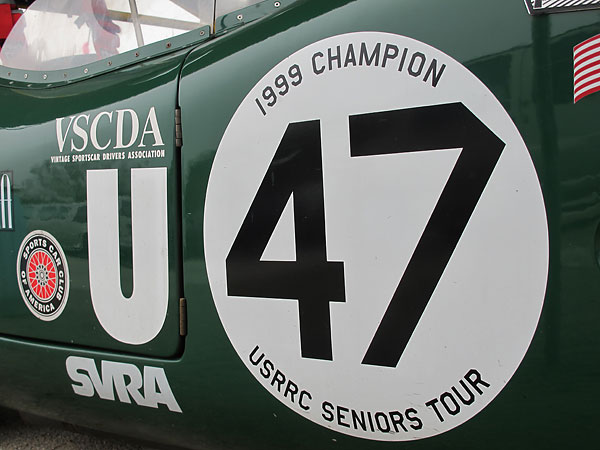
�
1999 Champion USRRC Seniors Tour
�
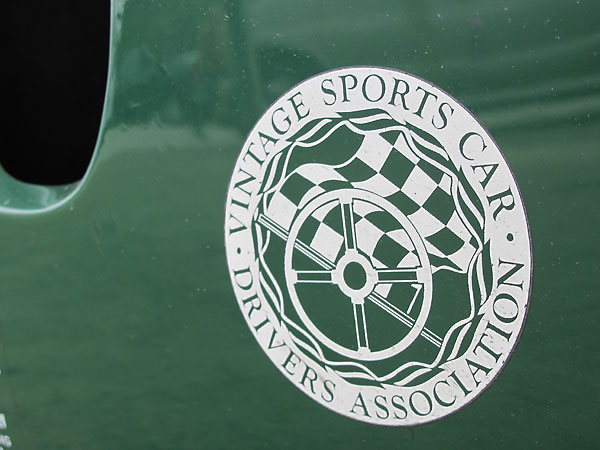
�
Vintage Sports Car Drivers Association decal.
�
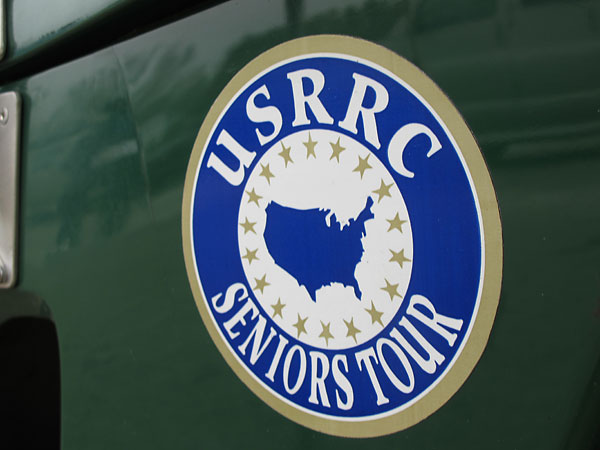
�
USRRC Seniors Tour decal.
�
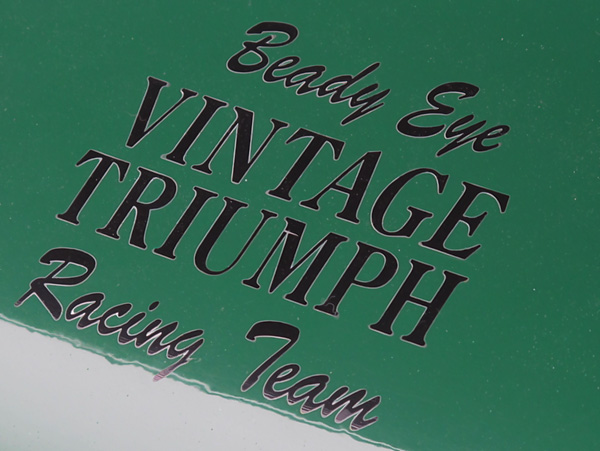
�
Beady Eye VINTAGE TRIUMPH Racing Team decal.
�
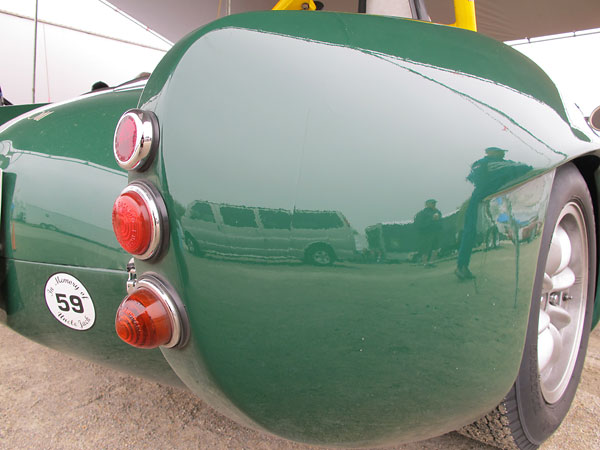
�
"In Memory of Uncle Jack". Jack Drews (1936-2008) was a very well loved racer and tuner
�
of Triumph sportscars. He used to drive a gorgeous blue and white Triumph TR4 (#59).
�
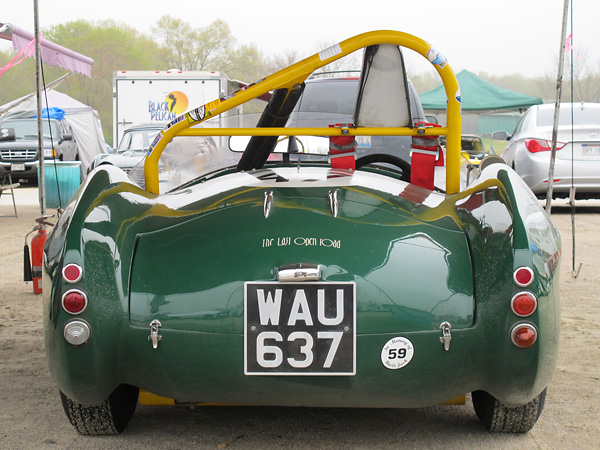
�
Registration number WAU637 was assigned to the first Tornado ThunderBolt. In Britain, a registration
�
number stays associated with a car even when ownership transfers. In the United States, license plate
�
numbers almost always change with ownership and often for other reasons (change of tax status, change
�
of residence, lost or damaged tag, whim, etc.). WAU637 is displayed here as a tribute, not a deception.
�
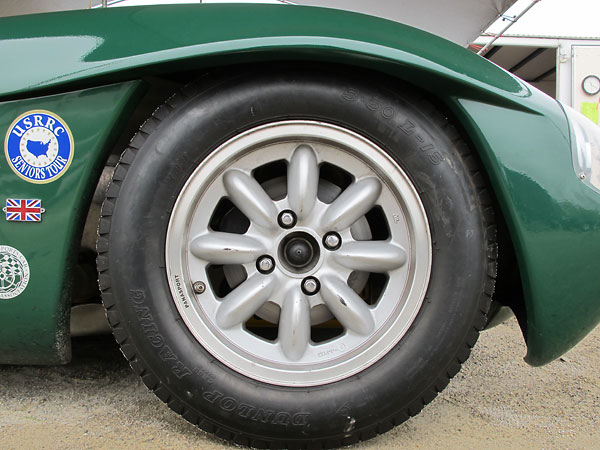
�
Panasport aluminum 8-spoke (6-JJx15) wheels.
�
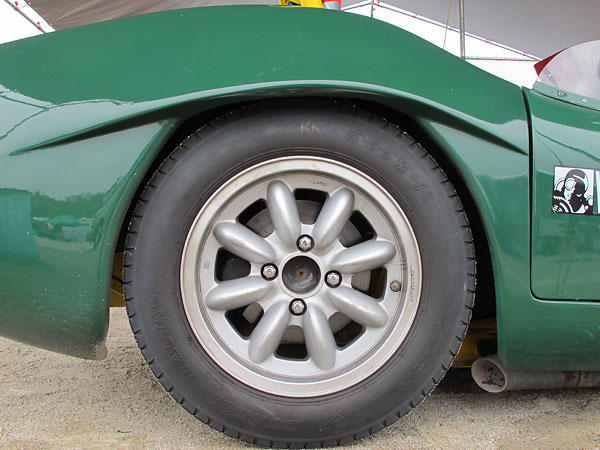
�
Dunlop Racing CR65 Mark II tires (5.50L-15 front and 5.00L-15 rear.)
�
Wider tires on the rear would certainly be desirable, but they simply don't fit.
�
�
| ThunderBolt WAU637 Race History — researched and compiled by Richard Page | ||||||
| Date | Venue | Club | Driver (car#) | Result | Notes (race name, class, race type, other.) | |
| 1960: | ||||||
| 3/19 | Goodwood | BARC(m) | Woodhouse (108) | retired | ClosedCars. Handicap. (First race!) | |
| 3/19 | Goodwood | BARC(m) | Martin (108) | did not start | Handicap. | |
| 5/21 | Silverstone | AMOC | Woodhouse (30) | Handicap. | ||
| 5/21 | Silverstone | AMOC | Woodhouse (30) | 3rd in class | "Martini 100." | |
| 5/21 | Silverstone | AMOC | Woodhouse (30) | Half hour speed trial. | ||
| 5/29 | Brands Hatch | BRSCC | Martin (62) | UnlimitedSports. Driver change (from Woodhouse.) | ||
| 6/11 | Silverstone | 8Clubs | Woodhouse (85) | 2nd | 5 lap sprint. Driver change (from Martin.) | |
| 6/11 | Silverstone | 8Clubs | Hextall (85) | 2nd | Handicap. Driver change (from Woodhouse.) | |
| 6/11 | Silverstone | 8Clubs | Woodhouse (85) | Half hour speed trial. | ||
| 6/18 | Silverstone | NSCC | Woodhouse (117) | 6th | Sports+1100. (Motoring News report refers to Hextall.) | |
| 6/18 | Silverstone | NSCC | Hextall (117) | 3rd | Prod+1600. (Autosport report refers to Woodhouse.) | |
| 6/18 | Silverstone | NSCC | Martin (117) | FormulaLibre. | ||
| 6/25 | Silverstone | MMEC | Martin (14) | UnlimitedSports. | ||
| 6/25 | Silverstone | MMEC | Woodhouse (12) | Handicap. | ||
| 7/3 | Brands Hatch | BRSCC(m) | Hextall (47) | retired | UnlimitedSports. Driver change (from Woodhouse.) | |
| 7/3 | Brands Hatch | BRSCC(m) | Martin (47) | 2nd | MarqueSports. Driver change (from Woodhouse.) | |
| 7/9 | Goodwood | BARC (m) | Martin (40) | 4th | Handicap. | |
| 7/9 | Goodwood | BARC (m) | Martin (40) | 10th | UnlimitedSports. | |
| 7/9 | Goodwood | BARC (m) | Woodhouse (40) | 8th | Handicap. | |
| 7/10 | Snetterton | SMRC | Martin (73) | unplaced | Sports. | |
| 7/10 | Snetterton | SMRC | Martin (73) | unplaced | GT. | |
| 7/17 | Brands Hatch | BRSCC | Martin (27) | unplaced | "Lords Taverners charity." UnlimitedSports. 11th on starting grid. | |
| 7/31 | Snetterton | 750MC | Martin (114) | Closed cars. | ||
| 8/13 | Silverstone | 750MC | Martin (Team32) | 1st | Six Hour Relay (three car team). | |
| 8/21 | Snetterton | WEMC | Martin (47) | 3rd (2nd/class) | GT | |
| 12/26 | Brands Hatch | BRSCC | Hextall (74) | 3rd (2nd/class) | (Boxing Day.) GT | |
| 1961: | ||||||
| 3/11 | Goodwood | BARC (m) | Hextall (24) | unplaced | UnlimitedSports. | |
| 3/25 | Snetterton | SMRC | Hextall (30) | 4th/+2.0class | "Lombank Trophy." GT.¹ | |
| 4/3 | Brands Hatch | BRSCC | Hextall (58) | 3rd (1st/class) | (Easter.) GT. | |
| 4/23 | Brands Hatch | BRSCC(m) | Hextall (76) | 5th | GT. | |
| 5/13 | Silverstone | AMOC | Hextall (12) | unplaced | "Martini 100." Sports. | |
| 5/22 | Goodwood | BARC | Hextall (125) | retired | (Whitsun holiday.) GT. | |
| 6/18 | Snetterton | ECMC | Hextall (101) | 3rd | "Autosport Championship." | |
| 1962: | ||||||
| 3/31 | Silverstone | BRSCC | Martin (116) | GT+1300. | ||
| 4/23 | Brands Hatch | BRSCC | Martin (116) | did not arrive | (Easter.) "Peco Trophy." GT+1600. | |
| 5/6 | Brands Hatch | BRSCC(m) | Martin (50) | retired | "Peco Trophy." GT1600-3000. (Qualified 7th.) | |
| 6/11 | Snetterton | RCC | ? (179) | Sports. Hextall was pre-registered driver. | ||
| 7/8 | Snetterton | LMC | Hutchings (44) | High Speed Trial. | ||
| 7/8 | Snetterton | LMC | Martin (44) | did not start | MarqueSports. Mike Hutchings was pre-registered driver. | |
| 7/8 | Snetterton | LMC | Martin (44) | unplaced | "J.Fairman Trophy." GT/Saloon. Mike Hutchings was pre-registered driver. | |
| ¹ | The Lombank Trophy was a supporting race to a Formula One feature, run under FIA Appendix J Group 3 rules. The rules, including a 100 car homologation requirement, must have been bent to allow WAU637 to compete. | |||||
| | ||||||
| Guide to De-Coding the British Racing Clubs that WAU637 Raced With: | ||||||
| AMOC | Aston Martin Owners Club | |||||
| BARC | British Automobile Racing Club | |||||
| BRSCC | British Racing and Sports Car Club | |||||
| 8Clubs | Eight Clubs (a consortium of smaller clubs) | |||||
| NSCC | Nottingham Sports Car Club | |||||
| MMEC | Midland Motor Enthusiasts Club | |||||
| SMRC | Snetterton Motor Racing Club | |||||
| 750MC | 750 Motor Club | |||||
| WECC | West Essex Car Club | |||||
| ECMC | Eastern Counties Motor Club | |||||
| RCC | Racing Car Club | |||||
| LMC | London Motor Club | |||||
| (m) | (members-only events) | |||||
�
All photos shown here are from April 2011 when we viewed the car at VDCA/VRG's "Wild Hare Run" �
at Virginia International Raceway. All photos by Curtis Jacobson for BritishRaceCar.com, copyright 2011. �
All rights reserved.
�
| If you liked this article, you'll probably also enjoy these: | �|||||
 | �
Bill Hart '57 Devin-Triumph | �
 | �
Mark Rosenberg '59 Peerless GT | �
 | �
George Wright '61 Triumph TR4 | �
| You're invited to discuss anything you've seen here on The British Racecar Motorsports Forum! | �|||||
�
Notice: all the articles and almost all the photos on BritishRacecar.com are by Curtis Jacobson.
�
(Photos that aren't by Curtis are explicitly credited.) Reproduction without prior written permission is prohibited.
�
Contact us to purchase images or reproduction permission. Higher resolution images are optionally available.
�

 �
�
